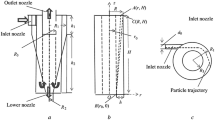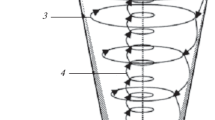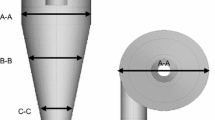On the basis of hydrodynamic equations, the structure of the flow of a suspension in a hydrocyclone and the separation of isothermal nonspherical particles in it were investigated numerically. A mathematical model is proposed for calculating the separation parameters of the indicated particles and their concentration field. It is shown that the most marked dependence of the separation parameters of suspension particles on their shape is characteristic of the particles whose sizes fall within the range 10 < dp < 50 μm and that the separation of such particles should be conducted taking into account the possible deviation of their shape from the spherical one.
Similar content being viewed by others
References
A. I. Povarov, Hydrocyclones at Concentrating Mills [in Russian], Nedra, Moscow (1978).
L. Svarovsky, Hydrocyclones, Technomic Publishing, London (1984).
Th. Neesse, D. Espig, and H. Schubert, Die Trennkorngrösse des Hydrozyklons bei Dünnstrom- und Dichtstrom-Trennungen, Proc. 1st European Symp. on Particle Classification in Gases and Liquids, Nuremberg, FRG (1984).
Th. Neesse, W. Dallman, and D. Espig, Effect of turbulence on the efficiency of separation in hydrocyclones at the high feed solids concentration, Proc. 2nd Int. Conf. on Hydrocyclones, Bath, England (1984).
Th. Neesse, V. Golyk, P. Kaniut, and V. Reinsch, Hydrocyclone control in grinding circuits, Miner. Eng., No. 17, 1237–1240 (2004).
Th. Neesse, M. Schneider, V. Golyk, and H. Tiefel, Measuring the operating state of the hydrocyclone, Miner. Eng., No. 17, 697–703 (2004).
Th. Neesse, M. Schneider, J. Dueck, V. Golyk, M. Buntenbach, and H. Tiefel, Hydrocyclone operation at the transition point rope/spray discharge, Miner. Eng., No. 17, 733–737 (2004).
D. A. Baranov, A. M. Kutepov, and M. G. Lagutkin, Calculation of separation processes in hydrocyclones, Teor. Osn. Khim. Tekhnol., 30, No. 2, 117–122 (1996).
I. G. Ternovskii and A. M. Kutepov, Hydrocycloning [in Russian], Nauka, Moscow (1994).
A. M. Kutepov, M. G. Lagutkin, and V. I. Mushtaev, Separation of heterogeneous systems in a straight-through-fl ow cylindrical hydrocyclone, Khim. Neft. Mashinostr., No. 7, 14–17 (2002).
A. M. Kutepov, M. G. Lagutkin, V. I. Mushtaev, and S. Yu. Bulychev, Simulation of the separation process in a straightthrough-flow cylindrical hydrocyclone, Teor. Osn. Khim. Tekhnol., 37, No. 3, 251–257 (2003).
A. M. Kutepov, M. G. Lagutkin, G. V. Pavlobskii, and V. I. Mushtaev, Separation of disperse systems in hydrocyclones with additional introduction of a dispersing gas, Teor. Osn. Khim. Tekhnol., 33, No. 5, 571–577 (1999).
V. O. Yablonskii, Influence of the regime parameters of a cylindrical hydrocyclone on the hydrodynamics of the flow of a nonlinearly viscoplastic fluid, Izv. Volgograd. Gos. Tekh. Univ., 7, No. 1 (128), 127–131 (2014).
V. O. Yablonskii, Influence of the design of a hydrocyclone on the efficiency of the degassing of Newtonian liquids, Izv. Volgograd. Gos. Tekh. Univ., 6, No. 1 (104), 27–31 (2013).
V. O. Yablonskii, Simulation of the separation of suspensions by the two-stage pressure flotation in a straight-throughflow cylindrical hydrocyclone, Zh. Prikl. Khim., 80, No. 3, 399–406 (2007).
V. O. Yablonskii and G. V. Ryabchuk, Analysis of the influence of the regime parameters of a cylindroconical hydrocyclone on the pressure flotation of the solid-phase particles in a suspension with a non-Newtonian disperse medium, Khim. Prom., 83, No. 2, 62–72 (2006).
V. O. Yablonskii and G. V. Ryabchuk, Flow of a rheologically complex suspension in a cylindroconical hydrocyclone, Teor. Osn. Khim. Tekhnol., 39, No. 4, 355–361 (2005).
J. G. Dueck, O. V. Matvienko, and Th. Neesse, Simulation of the hydrodynamics and separation in a hydrocyclone, Teor. Osn. Khim. Tekhnol., 34, No. 5, 478 –488 (2000).
O. V. Matvienko, Analysis of turbulence models and investigation of the structure of the flow in a hydrocyclone, J. Eng. Phys. Thermophys., 77, No. 2, 316–323 (2004).
O. V. Matvienko and J. G. Dueck, Numerical investigation of the separation characteristics of a hydrocyclone in different regimes of loading of a solid phase, Teor. Osn. Khim. Tekhnol., 40, No. 1, 1–6 (2006).
O. V. Matvienko and E. V. Evtyushkin, Theoretical investigation of the process of cleaning oil polluted soil in hydrocyclone apparatuses, J. Eng. Phys. Thermophys., 80, No. 3, 502–510 (2007).
O. V. Matvienko and E. V. Evtyushkin, Mathematical study of hydrocyclone dispersed phase separation in cleaning viscoplastic drilling fluids, J. Eng. Phys. Thermophys., 84, No. 2, 241–250 (2011).
O. V. Matvienko and M. V. Agafontseva, Numerical investigation of the degassing process in a hydrocyclone, Vestn. Tomsk. Gos. Univ., Mat. Mekh., No. 4 (20), 107–118 (2012).
O. V. Matvienko, A.O. Andropova, and M. V. Agafontseva, Influence of the regime of flow of particles from a hydrocyclone on its separation characteristics, J. Eng. Phys. Thermophys., 87, No. 1, 24–37 (2014).
A. Ya. Malkin and A. I. Isaev, Rheology: Conceptions, Methods, Applications [in Russian], Professiya, St. Petersburg (2007).
J. S. Laskowski, Coal Flotation and Fine Coal Utilization, Elsevier, Amsterdam (2001).
A. Gupta, D. Lilly, and N. Sayred, Swirling Flows [Russian translation], Mir, Moscow (1987).
O. V. Matvienko, V. P. Bazuev, N. G. Turkasova, and A. I. Baigulova, Investigation of the modification of bitumen in an engineering mixer, Vestn. Tomsk. Gos. Arkh.-Str. Univ., No. 3, 202–213 (2013).
F. R. Menter, Zonal two equation k–ω turbulence models for aerodynamic flows, AIAA Paper, 93-2906 (1993).
F. R. Menter and C. L. Rumsey, Assessment of two-equation turbulence models for transonic flows AIAA Paper, 94-2343 (1994).
J. Piquet, Turbulent Flows: Models and Physics, Springer, Berlin (1999).
W. P. Jones and B. E. Launder, The calculation of low Reynolds number phenomena with a two-equation model of turbulence, Int. J. Heat Mass Transf., 16, 1119−1130 (1973).
D. C. Wilcox, A two-equation turbulence model for wall-bounded and free-shear flows, AIAA Paper, 2905 (1993).
F. R. Menter, M. Kuntz, and R. Langtry, Ten years of industrial experience with the SST turbulence model, in: Turbulence, Heat and Mass Transfer 4, Begell House Inc. (2003), pp. 625–632.
P. R. Spalart and M. Shur, On the sensitization of turbulence models to rotation and curvature, Aerospace Sci. Technol., 1, Issue 5, 297–302 (1997).
P. Bradshaw, D. H. Ferriss, and N. P. Atwell, Calculation of boundary layer development using the turbulent energy equation, J. Fluid Mech., 28, 593–616 (1967).
O. V. Matvienko, V. M. Ushakov, and E. V. Evtyushkin, Mathematical simulation of the turbulent transfer of the disperse phase in a turbulent flow, Vestn. Tomsk. Gos. Ped. Univ., No. 6, 50–54 (2004).
O. V. Matvienko, O. I. Daneiko, and T. A. Moreva, Determination of the shape of the free surface formed by the flow over piers, Vestn. Tomsk. Gos. Arkh.-Str. Univ., No. 1 (38), 101–107 (2013).
Yu. N. Grigor’ev, V. A. Vshivkov, and M. P. Fedoruk, Numerical Simulation by Methods of Particles in Cells [in Russian], Izd. Sib. Otd. Ross. Akad. Nauk, Novosibirsk (2004).
Bing Chen, Yucheng Li, and Guozhang Lai, A finite element model of gravity waves with free surface, Int. Offshore Polar Eng., 9, No. 4, 113–125 (1999).
O. M. Belotserkovskii and Yu. M. Davydov, Calculation of transonic “overcritical” flow regimes by the method of “large particles,” Zh. Vych. Mat. Mat. Fiz., 13, No. 1, 147–171 (1973).
L. G. Strakhovskaya, Numerical Simulation of Two-Phase Flows with a Moving Interface by the Method of Finite Superelements, Preprint No. 83 of the Inst. Prikl. Matem. im. M. V. Keldysha (2010).
C. W. Hirt and B. D. Nichols, Volume of fluid (VOF) method for the dynamics of free boundaries, J. Comput. Phys., 39, 201–225 (1981).
D. J. E. Harvie and D. F. Fletcher, A new volume of fluid advection algorithm: the stream scheme, J. Comput. Phys., 162, No. 1, 1–32 (2000).
M. S. Kim, J. S. Park, and W. I. Lee, A new VOF-based numerical scheme for the simulation of fluid flow with free surface. Part II: Application to the cavity filling and sloshing problems, Int. J. Numer. Methods Fluids, 42, 791–812 (2003).
S. Tiwari and J. Kuhnert, Modeling of two-phase flows with surface tension by finite pointset method (FPM), J. Comput. Appl. Math., 203, Issue 2, 376–386 (2007).
C. Crowe, M. Sommerfeld, and Ya. Tsuji, Multiphase Flows with Droplets and Particles, CRC Press (1998).
O. V. Matvienko, E. V. Evtyushkin, and A. O. Andropova, Investigation of the applicability of a drift model of particles for simulation of the transfer of a dispersed phase in a flow, Vestn. Tomsk. Gos. Univ., Mat. Mekh., No. 5 (37), 76–83 (2015).
O. V. Matvienko, A. V. Andriasyan, N. A. Mamadraimova, and A. O. Andropova, Investigation of the movement of a particle shaped as an elongated ellipsoid of revolution in a swirling flow, Vestn. Tomsk. Gos. Univ., Mat. Mekh., No. 3 (41), 74–85 (2016).
A. Haider and O. Levenspiel, Drag coefficient and terminal velocity of spherical and nonspherical particles, Powder Technol., 58, 63–70 (1989).
O. V. Matvienko and A. M. Daneiko, Investigation of the collision interaction of particles in a flow, Izv. Vyssh. Ucheb. Zaved., 56, No. 9/3, 190–192 (2013).
G. M. Ostrovskii, Applied Mechanics of Inhomogeneous Media [in Russian], Nauka, St. Petersburg (2000).
D. Bradley, The Hydrocyclone, Pergamon Press, London (1965).
H. Trawinski, Der Hydrozyklon als Hilfsgerät zur Grundstoffveredelung, Chem. Ing. Tech., 25, No. 6, 331–340 (1953).
T. C. Monredon, K. T. Hsien, and R. K. Rajamani, Fluid flow model of the hydrocyclone: an investigation of device dimensions, Int. J. Miner. Process., 35, No. 1, 65–83 (1992).
S. Patankar, Numerical Methods of Solving Problems on Heat and Mass Exchange and Fluid Dynamics [Russian translation], Énergoatomizdat, Moscow (1983).
J. H. Ferziger and M. Perič, Computational Methods for Fluid Dynamics, Springer, Berlin (1996).
B. Van Leer, Towards the ultimate conservative differencing scheme. IV. A new approach to numerical convection, J. Comput. Phys., 23, 276–299 (1977).
A. Harten, High resolution schemes for hyperbolic conservation laws, J. Comput. Phys., 49, 357–393 (1983).
J. P. Van Doormal and G. D. Raithby, Enhancements of the SIMPLE method for predicting incompressible fluid flows, Numer. Heat Transf., 7, 147−163 (1984).
O. V. Matvienko and A. O. Andropova, Investigation of the movement of a particle in a fluid flow near a moving wall, Vestn. Tomsk. Gos. Univ., Mat. Mekh., No. 4, 85–92 (2015).
Author information
Authors and Affiliations
Corresponding author
Additional information
Translated from Inzhenerno-Fizicheskii Zhurnal, Vol. 91, No. 3, pp. 761–778, May–June, 2018.
Rights and permissions
About this article
Cite this article
Matvienko, O.V., Andropova, A.O. Separation of Nonspherical Particles in a Hydrocyclone. J Eng Phys Thermophy 91, 712–730 (2018). https://doi.org/10.1007/s10891-018-1794-z
Received:
Published:
Issue Date:
DOI: https://doi.org/10.1007/s10891-018-1794-z




